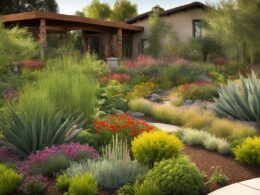Welcome to our guide on xeriscaping, a landscaping approach that aims to conserve water and create low-maintenance gardens in residential landscapes. Whether you live in an arid region or want to reduce your water usage, xeriscaping can transform your outdoor space into a sustainable and attractive oasis. In this article, we will introduce you to the basics of xeriscaping and guide you through the key principles and benefits of this eco-friendly landscaping technique.
Key Takeaways:
- Xeriscaping is a landscaping approach that conserves water and creates low-maintenance gardens in residential landscapes.
- It originated in Denver, Colorado in response to severe drought conditions and has since been adopted in various parts of the country.
- Xeriscaping involves careful planning, soil improvement, appropriate plant selection, efficient irrigation, mulching, and regular maintenance.
- Benefits of xeriscaping include water savings, drought resistance, low-maintenance landscapes, and eco-friendly practices.
- By implementing xeriscaping principles, homeowners can reduce water usage and enjoy beautiful landscapes that require minimal effort to maintain.
What is Xeriscape?
Xeriscape, derived from the Greek word “xeros” meaning dry, is a landscaping approach that focuses on water conservation. It originated in Denver, Colorado in the 1980s during a severe drought. Xeriscape allows for the use of small amounts of water while maintaining a traditional look in landscapes. It has been adopted in various regions experiencing drought or long-term dry conditions. Xeriscape practices vary depending on the climate, with some areas emphasizing dry desert landscaping while others focus on more careful planning, efficient irrigation, and use of drought-tolerant plants.
With xeriscape, you can create a beautiful and sustainable landscape that requires less water and maintenance, making it perfect for residential areas facing water scarcity or drought conditions. The traditional look of xeriscape allows you to have the lush greenery and attractive features of a well-maintained garden while conserving water and reducing your environmental impact.
One of the key aspects of xeriscape is the careful selection of drought-tolerant plants that can thrive in your specific climate. By choosing plants that are naturally adapted to withstand dry conditions, you can minimize water requirements and still enjoy a vibrant and diverse landscape. Additionally, efficient irrigation methods, such as drip irrigation, can further reduce water usage by delivering water directly to the roots of plants, minimizing evaporation and runoff. By implementing xeriscape principles, you can create a visually appealing and sustainable landscape that benefits both your home and the environment.
Benefits of Xeriscape
Xeriscape offers numerous benefits, including water savings, drought resistance, and the creation of low-maintenance, eco-friendly landscapes.
- Water Savings: Xeriscape can reduce water usage by up to 50-75% compared to traditional landscaping methods, helping you conserve this valuable resource.
- Drought Resistance: By incorporating drought-tolerant plants and efficient irrigation techniques, xeriscaped landscapes are better equipped to withstand periods of water scarcity or drought.
- Low-Maintenance: Xeriscape requires less maintenance compared to traditional landscapes, as the use of drought-tolerant plants minimizes the need for frequent watering and other upkeep tasks.
- Eco-Friendly: Xeriscaping promotes environmental sustainability by reducing water usage, eliminating the need for synthetic fertilizers and pesticides, and minimizing runoff of harmful substances into water bodies.
Benefits of Xeriscape
Xeriscape offers a multitude of benefits for residential landscapes, making it an ideal choice for environmentally conscious homeowners. One of the primary advantages of xeriscaping is water savings. Traditional landscaping practices often result in excessive water usage, leading to wastage and higher utility bills. By implementing xeriscape techniques, you can reduce water consumption by up to 54 percent without compromising the health and beauty of your landscape.
In addition to water savings, xeriscaping also enhances the drought resistance of your yard. During periods of water shortages or drought, xeriscaped landscapes have improved resilience as they are designed to thrive with minimal water requirements. This allows you to maintain a lush and vibrant yard even during challenging environmental conditions.
Another significant benefit of xeriscape is its low-maintenance nature. Traditional landscapes often require high levels of upkeep, including regular mowing, fertilization, and pest control. Xeriscaped yards, on the other hand, minimize the need for these time-consuming tasks. By incorporating drought-tolerant plants and reducing turf areas, you can enjoy a beautiful and thriving landscape that requires less maintenance.
Furthermore, xeriscape is an eco-friendly landscaping approach. By eliminating the need for synthetic fertilizers and pesticides, xeriscaping promotes a healthier environment by reducing the runoff of toxic materials and chemicals into streams and rivers. Additionally, xeriscaped landscapes contribute to the conservation of water resources, helping to preserve the natural ecosystem.
Key Benefits of Xeriscape:
- Water savings up to 54 percent
- Improved drought resistance
- Low-maintenance landscaping
- Eco-friendly practices
“Xeriscape focuses on water conservation, making it an excellent choice for homeowners who want a beautiful landscape while minimizing their environmental impact.” – Landscaping Expert
How to Xeriscape Your Yard
Xeriscaping your yard involves careful planning, soil improvement, turf management, plant selection, mulching, efficient irrigation, and regular maintenance. Follow these steps to create a beautiful and water-efficient landscape:
1. Plan Your Landscape
Start by creating a well-thought-out design for your xeriscape yard. Consider factors such as sun exposure, soil type, and the desired use areas. Map out zones based on water needs and plan for efficient irrigation systems.
2. Improve Your Soil
Prepare your soil by improving its structure to allow for proper drainage and moisture retention. Incorporate organic matter, like compost, into the soil to enhance its water-holding capacity and nutrient content.
3. Manage Turf Areas
Minimize the amount of turf grass in your xeriscape yard to reduce water usage. Limit turf areas to practical spaces and consider using alternative grasses or ground covers that require less water. This will help conserve water and decrease maintenance needs.
4. Select Drought-Tolerant Plants
Choose plants that are well-suited to your region’s climate and water conditions. Group plants with similar water requirements together to maximize water efficiency. Opt for native or drought-tolerant species that can thrive with minimal watering.
5. Mulch for Water Conservation
Apply a layer of organic mulch around plants and in garden beds to help conserve moisture, suppress weed growth, and regulate soil temperature. Mulching reduces water evaporation from the soil surface and minimizes the need for frequent watering.
6. Implement Efficient Irrigation
Use efficient irrigation methods, such as drip irrigation or micro-sprinklers, to deliver water directly to the root zone of plants. This reduces water wastage by avoiding runoff and minimizing evaporation. Install a rain sensor or moisture sensor to prevent overwatering.
7. Maintain Your Xeriscape
Regular maintenance is crucial for the health and longevity of your xeriscape yard. This includes weeding, pruning, fertilizing, and pest control. Monitor your plants’ water needs and adjust your irrigation system accordingly. With proper care, your xeriscape will continue to thrive and conserve water.
By following these steps, you can transform your yard into a water-efficient and low-maintenance xeriscape landscape. Enjoy the beauty of your sustainable garden while conserving water and supporting the environment.
Xeriscaping Principles
Implementing xeriscaping principles in your residential landscape can help you create a water-efficient and low-maintenance garden. By following these seven basic principles, you can transform your yard into a sustainable and attractive outdoor space.
1. Planning and Design
When considering xeriscaping, it’s important to plan and design your landscape with water and energy conservation strategies in mind. Take into account the specific climate and regional conditions to create a layout that optimizes water usage and reduces waste.
2. Soil Improvement
Creating a soil structure that allows for proper drainage and moisture retention is crucial for the success of your xeriscape garden. Enhance the quality of your soil by incorporating organic matter, such as compost, to improve its water-holding capacity.
3. Practical Turf Areas
Limiting the amount of turf areas in your landscape is a key component of xeriscaping. Instead of traditional grass, consider using alternative grasses or ground covers that are low-maintenance and drought-tolerant. This reduces the need for excessive watering and mowing.
4. Plant Selection
When selecting plants for your xeriscape garden, it’s essential to choose species that are well-adapted to your regional climate and water needs. Group plants with similar water requirements together to optimize irrigation practices and minimize water wastage.
5. Mulching
Mulching plays a significant role in conserving water in xeriscaping. Apply a layer of organic mulch, such as wood chips or bark, around plants to reduce evaporation, suppress weed growth, and regulate soil temperature.
6. Efficient Irrigation
Implementing efficient irrigation methods is crucial for water conservation in xeriscaping. Drip irrigation systems deliver water directly to the plant roots, minimizing water loss to evaporation and ensuring efficient water usage.
7. Landscape Maintenance
Regular maintenance is necessary to keep your xeriscape landscape healthy and thriving. This includes weeding, pruning, fertilizing, and pest control. By staying on top of maintenance tasks, you can ensure the long-term success of your water-efficient garden.
How Do Xeriscaping Principles Differ for Urban and Residential Landscapes?
When it comes to xeriscaping urban areas versus residential landscapes, the principles of xeriscaping urban areas may differ due to the limited space and different environmental conditions. In urban areas, the focus may be on utilizing small spaces efficiently, choosing drought-resistant plants, and incorporating sustainable irrigation systems to conserve water.
Conclusion
Xeriscaping offers numerous benefits for homeowners looking to create sustainable and attractive outdoor spaces. By implementing xeriscaping principles, you can conserve water, increase the resilience of your yard to drought conditions, and enjoy the beauty of a low-maintenance landscape.
One of the key advantages of xeriscaping is water conservation. With traditional landscaping practices being wasteful, xeriscaping can reduce your water usage by up to 54 percent without compromising the health and beauty of your yard. By carefully planning your landscape, improving your soil, selecting drought-tolerant plants, and using efficient irrigation methods, you can create a landscape that thrives while minimizing water waste.
In addition to water conservation, xeriscaping offers the benefit of low-maintenance landscaping. By limiting turf areas and using alternative grasses or ground covers, you can reduce the need for mowing and other time-consuming maintenance tasks. Mulching helps to conserve water by reducing evaporation and weed growth, further reducing the need for regular maintenance. With xeriscaping, you can spend less time tending to your yard and more time enjoying it.
So, whether you live in an area experiencing water shortages or simply want to create a more eco-friendly landscape, xeriscaping is a smart choice. By incorporating xeriscaping principles into your yard, you can reap the benefits of water conservation, drought resistance, and low-maintenance landscaping. Transform your residential landscape into a beautiful and sustainable outdoor space with xeriscaping.













